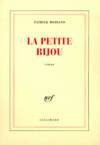La Petite Bijou
Patrick Modiano - Paris, Gallimard (Coll. Blanche), 2001, 160 p.

« “Quand j’avais sept ans, on m’appelait la Petite Bijou.” Il a souri. Il trouvait certainement cela charmant et tendre pour une petite fille. Lui aussi, j’en étais sûre, sa maman lui avait donné un surnom qu’elle lui murmurait à l’oreille, le soir, avant de l’embrasser. Patoche. Pinky. Poulou. “Ce n’est pas ce que vous croyez, lui ai-je dit. Moi, c’était mon nom d’artiste.”» (Quatrième de couverture)
Documentation critique
NELSON, Jeanne-Andrée, « La mère modèle dans La Petite Bijou de Modiano », dans John E. FLOWER (dir.), Patrick Modiano, Amsterdam, Rodopi (Faux Titre), 2007, p. 179-193. +++ Chapitre de collectif
COOKE, Dervila, « La Petite Bijou : Autofictional Translations », dans John E. FLOWER (dir.), Patrick Modiano, Amsterdam, Rodopi (Faux Titre), 2007, p. 195-209. +++ Chapitre de collectif
GRENAUDIER-KLIJN, France, « Comment dire “je”?: Le “je” féminin dans deux romans de Patrick Modiano », dans Adrienne ANGELO et Erika FÜlÖP (dir.), Protean Selves: First-Person Voices in Twenty-First-Century French and Francophone Narratives, Newcastle upon Tyne, Cambridge Scholars, 2014, p. 96-108. +++ Chapitre de collectif
### Ce chapitre traite aussi de Dans le café de la jeunesse perdue. ###
KUPPER, Nelly Grossman, « Daughters Who Remember. The Omnipresent Mother in Sarraute’s Enfance and the Absent Mother in Modiano’s La Petite Bijou », dans Orbis Litterarum, vol. 66, no 3 (juin 2011), p. 171-193. +++ Article de revue
### « Pairing the novel of Enfance by Nathalie Sarraute with La Petite Bijou by Patrick Modiano lends a new perspective to the struggle of the female protagonist in both texts. Where the dominant critical view of both novels separately has presented the daughter as achieving a positive resolution to her struggle at the end of the text, deeper affinities between the narratives reveal a common denominator that debunks this perspective. Rereading the novels from the psychological framework of family systems theory, I suggest that the daughter wades unsuccessfully through issues of attachment and differentiation from her mother. In the two contrasting cases of Enfance, where attachment is too intense, and La Petite Bijou, where it is too feeble, the daughter is caught in the same persistent cycle of struggle and failure to gain autonomy, thereby demonstrating that a resolution that other critics want to see is equally impossible. » (résumé joint à l’article)
CELI DE MARCHINI, Marta, « Oubli, mort et renaissance dans La Petite Bijou de Patrick Modiano », dans Susana G. ARTAL (dir.), Estudios argentinos de literatura francesa y francófona: Los viajes, los viajeros y el olvido, Córdoba, Comunicarte, 2004, p. 161-173. +++ Chapitre de collectif
ULIASZ, Edyta, « La Petite Bijou: Permanence des motifs dans le dernier roman de Patrick Modiano », dans Roczniki Humanistyczne, vol. 50, no 5 (2002), p. 27-42. +++ Article de revue
MOLINIÉ, Georges, « Cliché et littérarité », dans Eric BORDAS et Catherine RANNOUX (dir.), Clichés et clichages, Poitiers, UFR des Lettres et des Langues de l’Université de Poitiers, 2001, p. 175-178. +++ Chapitre de collectif
BURGELIN, Claude, « De quoi se plaindre ? Comment se plaindre ? Une lecture de La petite Bijou », dans Roger-Yves ROCHE (dir.), Lectures de Modiano, Nantes, Éditions Cécile Defaut, 2009, p. 47-62. +++ Chapitre de collectif
COOKE, Dervila, Present Pasts : Patrick Modiano’s (Auto)Biographical Fictions, Amsterdam, Rodopi (Faux Titre), 2005, 356 p. +++ Monographie
### Voir le chapitre (iv): « La Petite Bijou: “J’avais rêvé tout ça” », p. 141-154. ###
| La Petite Bijou (oeuvre) | |
|---|---|
| Titre | La Petite Bijou |
| Auteur | Patrick Modiano |
| Parution | 2001 |
| Tri | Petite Bijou |
| Afficher | oui |